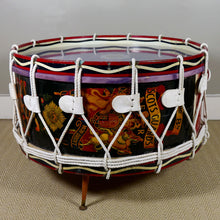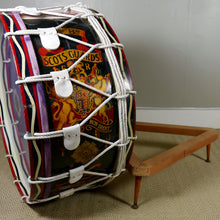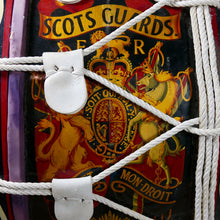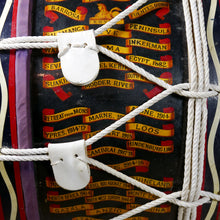2nd Battalion Scots Guards Corps of Pipes and Drums Bass Drum
Adding product to your cart
Circa 1939-1965
Measurements: Drum: 81cm (32in) x 40cm (1575in)
With painted ash hoops, rope tension system, wood cylinder, and hand painted regimental emblazon comprising title scroll, EIIR cypher, Royal arms and motto, and Star of the Order of the Thistle, ‘Unita Fortitor’ motto, and Battle Honours from Namur 1695 to Italy 1943-45. The cylinder’s interior pasted with maker’s labels of Henry Potter & Co. of Charing Cross with instructions for Drummers for ‘Lapping Drum Heads’.
Read more
This well travelled and venerable drum has a relatively long and interesting history best illustrated by the pencilled notes found inside the cylinder during recent cleaning. They track the 2nd Battalion’s deployment to Egypt before the Second World War; the hard won victory over Axis forces in North Africa that culminated in the Cape Bon peninsula (where, perhaps, we may assume the Pipes and Drums of the battalion participated in the 1943 Victory Parade in Tunis under the gaze of General Eisenhower), prior to the invasion of Italy. Its move to North-West Europe in March 1945 and return home in 1947. Further inscriptions were made during the 2nd Battalion’s deployments to West Germany with the 4th Guards Brigade, BAOR, from July 1953 to 1957, and to Kenya were it operated in support of the civil power and assisted in quelling mutinies in the Kenya Rifles and Uganda Rifles.
The inscriptions include:
‘Drummer Woodcock Egypt Mersa Matruh Relapped 12th March 1939
/ 1939-45 McCloskie take care of it you chancer Cape Bon / DMR Caldwell 1944-45 / Drummer Brayshaw Relapped 19 Dec 1945 Germany 1945-47 / Painted Dec 1950 / Painted Dec 1950 Dmr MacGregor / Painted Feb 1953 EIIR Drm Clarkson R. / Germany July 1953 / Relapped Sept 1954 / DMR Stott Kahawa Kenya 6.5.62. / Relapped on 29th March 1962 Muthaiga Camp Kenya by Dmr Hunter / L/Cpl Hunter Kenya 6.5.64 / Kenya Dmr Ashcroft 6-5-1964 / 15 mths to do 1-7-64 / DRM Watson L/Sgt Moyes for D/Sgt Smith’
It is interesting to find evidence of the drum being repainted on the accession of the Queen rather than being simply replaced. Similarly, the Second World War Battle Honours were added in a different hand, rather than the whole being repainted, as is often the case with side drums. Such suggests that this bass drum was regarded as something of a totemic object. Moreover this drum lived a second life as a low table, with Thistle Star cover and being raised on its specially constructed triangular base and legs. Military drums have long been regarded as trophies of war and used as tables both in the field and in domestic settings. It was a tradition made somewhat voguish in the 1950s by the Duke of Windsor who furnished his French country retreat, La Moulin de la Tuilerie, with a Guards bass drum in place of a coffee table.
The drum maker Henry Potter of Charing Cross, London was established as an independent concern in 1872. Hitherto Henry’s father, Henry senior, had run a drum making business at 30 Charing Cross since 1856. Prior to that, Henry senior ran his business from 2 Bridge Street, Westminster, having inherited an interest in drum making from his father Samuel, late drum-major Coldstream Guards, who left the Army in 1817. Other members of the extended Potter family were also engaged in the drum and flute making business for many generations. A notable contemporary being Henry senior’s brother George Potter of Aldershot whose firm continued the craft in the traditional manner until the introduction of rod tensioned and transfer decorated drums in 1960.










